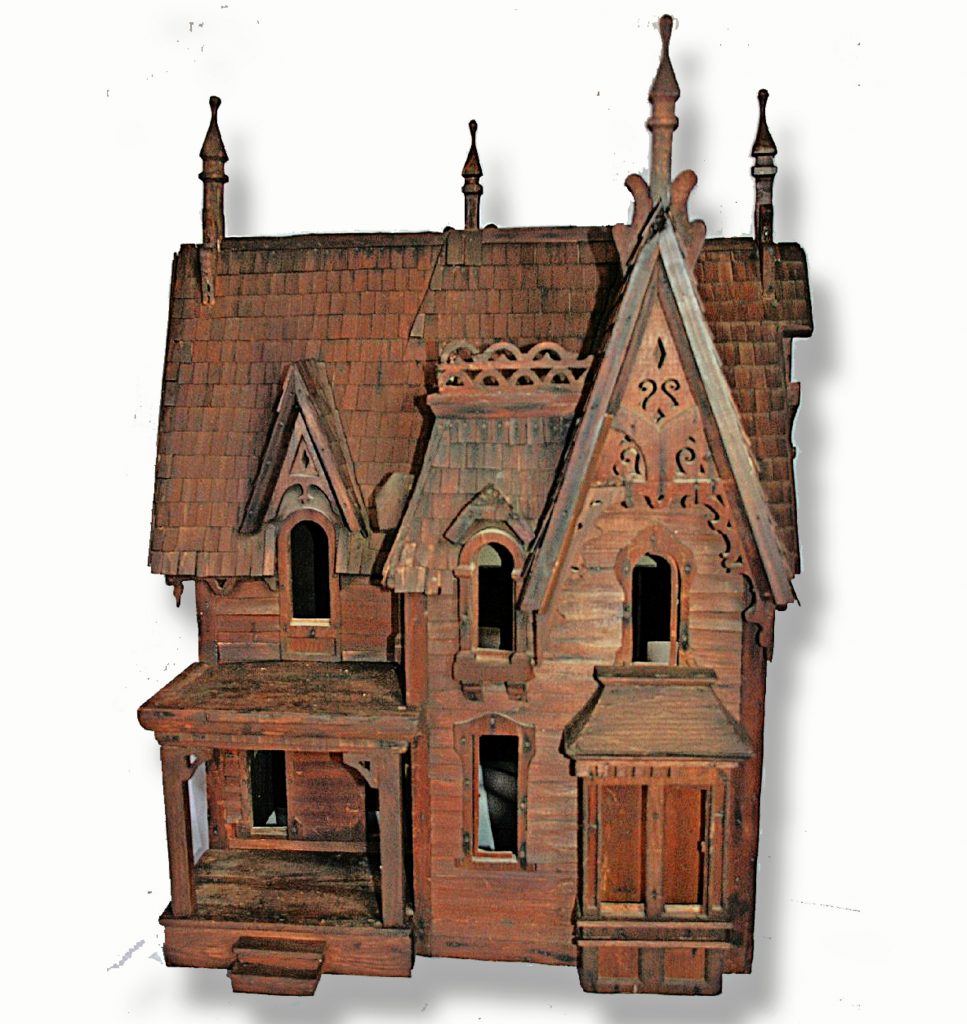WINNSBORO – In 1874, my great grandfather James M. Lawson, then about 17 years old, contracted scarlet fever. In the late nineteenth century, this was a much dreaded malady and a large number of children died from the untreatable effects of the disease.

While recuperating, James began assembling what would result in an exquisite miniature model of a two story Queen Anne townhouse, made of light wood from cigar boxes and other scraps probably found around his father’s tinsmith workshop and store. Family tradition does not reveal the extent of his infirmity and how long he spent in fashioning the proportionally exact multi-gabled house.
His father, Hiram W. Lawson, ran a tinners business just off the town square of Abbeville. The store also sold stoves and the stylized pressed roofing tin that was then becoming the vogue for new styled houses with steep sloped roofs, fancy turrets, and other decorative projections. Near the store was the equally successful livery business of Lewis M. Russell, who also sold liquors and spirits.
After young Lawson recovered, he married Mr. Russell’s daughter Josephine Boozer. Family lore has it that the young groom built for his bride a version of the beautiful little model house he had carved during his illness. James went to work in his father’s business, raising a family of five children. His first child, Antoinette, probably received the little house as a toy, although it seemed in later years that someone had taken very good care of it and not allowed the children to play roughly with it.
The dollhouse had remained in my grandmother’s possession, as she was the only other girl born into the family.
Thus the dollhouse came into my own childhood, and my siblings and cousins all took turns in playing with it, sadly mishandling the delicate isinglass (sheets of clear mica) windows and knocking them out of the frames. At some point I think my grandmother decided to take the model back into her possession, probably to protect the precious antique from further damage. In the late 1960s when Nanny had become too ill to live at home and was being placed in a nursing home, I remember seeing the dollhouse for the last time on her screened sleeping porch.
Shortly afterwards, the dollhouse disappeared, and my family assumed that someone had stolen it from the unlocked back porch. Through the years I had recurring dreams about the magical little house that so fascinated me, a child of artistic abilities who dreamed of becoming a sculptor or painter. My dreams centered around the intricate detailing of the gingerbread detailing on the eaves of the steep roof, the tiny individual wooden shingles, various gables and porches, and perfectly proportionate clapboards.
Many years later in the 1980s, when I was raising my two young daughters, I bought them a commercial kit to build a toy Victorian doll house. The modern toy had nothing to compare in the realism and detail of my great grandfather’s house, but I wanted my daughters to be able to dream and play with a dollhouse similar to the one I enjoyed. I often thought of the dark wooden model, sometimes dreaming about it. I remembered the precise detailing of its features and often wondered where it had ended up.
Some 26 years after the death of my grandmother and some 35 or more years since the disappearance of the little house, I had the most extraordinary encounter with the reincarnated dollhouse. As a museum professional, I attended an Old South conference and ball in Abbeville, where a concert of talented period musicians was held in the historic Queen Anne style McGowan-Barksdale-Bundy house.
Guests all attended in early Victorian costume and Confederate gray uniforms. Two large rooms, connected by a wide pocket doorway, were opened up to allow temporary seating for about 100 attendees, with the performances taking place in front of the library’s shelf-lined wall. As I entered with my friends in the rear of the audience, I found a seat in a front corner of the dining room facing the left edge of the pocket doorway. The wainscoting of the room was of dark mahogany, adding to the dim appearance of the room. I sat down in a metal folding chair and immediately leaned over to attend to a loose ribbon on my uncomfortable nineteenth-century styled shoe.
Raising my head and shoulders to sit up straight for the performance, a vision of the little dollhouse appeared two feet in front of my face on a corner table. I immediately recognized it from my childhood memories, without having to examine it further.
It had been completely restored with the exception of the window mullions and isinglass windows. I was so astounded that I quickly hurried from the room during the performance, to find and meet Mr. Bill Rogers in the entrance hall to ask about the house. Bill, I found out, is one of Abbeville’s Historical Society officers and the volunteer curator of the McGowan-Barksdale-Bundy House Museum, having been responsible for saving the house from dereliction. He related that a descendant of James Lawson had recently donated the miniature to the McGowan House and that it had been carefully restored by a local artisan.
Bill invited me to come back the following day during daylight hours to learn more about the donation and to take photographs of it. I learned that two cousins of mine, descendants of one of my grandmother’s brothers, had donated it to the Society. From this, I have learned that it was caring relatives, not thieves, who had removed the house from its unsecured storage on Nanny’s back porch in order to protect it.
As a museum director, I applaud my cousins for their decision to further protect the artifact by donating it to the museum house. The McGowan house is located a short distance from the house where James Lawson grew up, and future descendants of our family lines will be able to visit Abbeville and experience the same sights and feelings that must have existed when our ancestors walked the streets there. The town has retained much of its historic flavor, including the lovely little town square with its cobblestone and brick pavement and its continuously active Opera House.
Although the economic times have been hard on such small towns, I hope that the citizens of Abbeville will not forget its wonderful past and will realize that the preservation of its material features can be the gateway to a resurrection of vitality and community strength.
Pelham Lyles is Director of the Fairfield County Historical Museum in Fairfield County, South Carolina.












